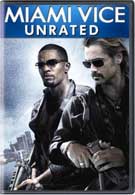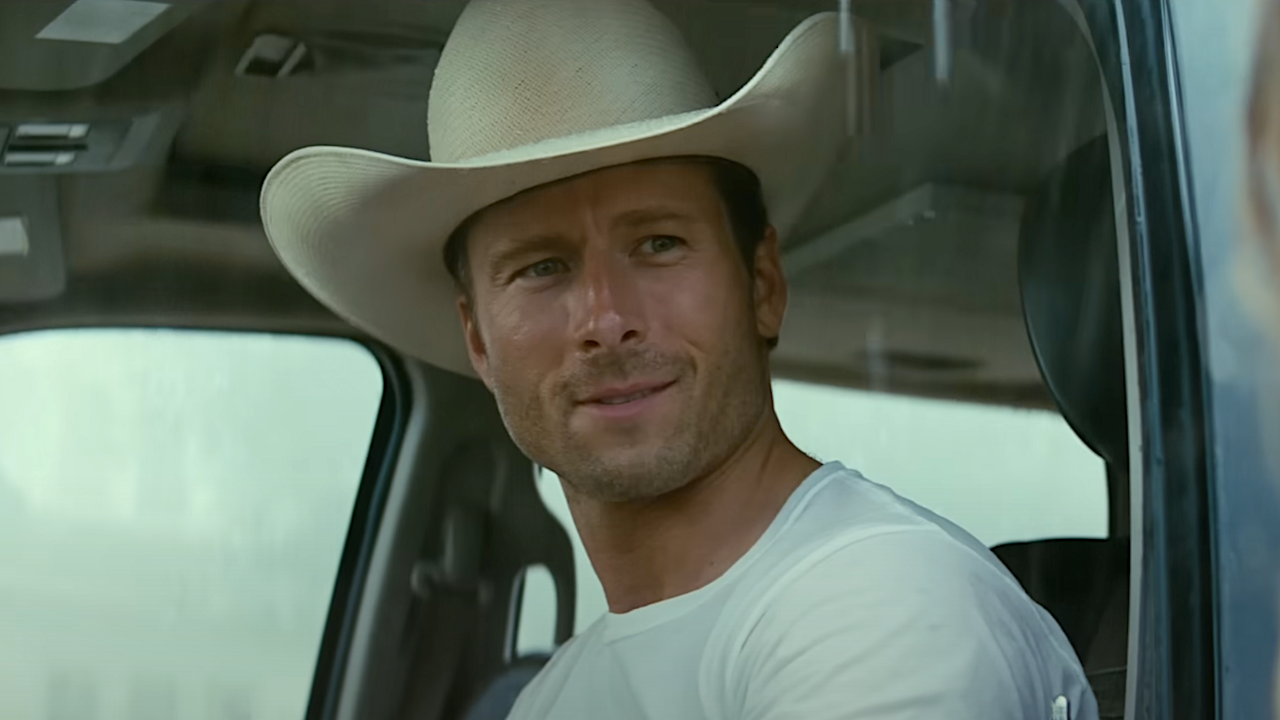If you have heard any criticism of Michael Mann’s Miami Vice, the film version of the 1980s television series, it was undoubtedly describing the movie as over-stylized. The movie, released in theaters last summer, met critics who described it as too heavy on look and design and weak on narrative. Mann’s icy lighting and grainy-textured images were probably a tough sell to devotees of the TV series (on which he served as producer, and writer of one episode), and an audience that probably anticipated more verbal interaction with the film’s two stars, two of the biggest names in Hollywood, Jaime Foxx and Colin Farrell. I can sympathize with an audience who anticipated the prototypical action film replete with explicit dialogue and testosterone-boosting shoot-outs (and there are still plenty of these), but most importantly, a nostalgic look back at the two TV heroes, Tubbs and Crockett. It’s tough to make an artistic picture from the glossy material of the TV show, but if there is a director to do it, it’s Mann. In the new unrated DVD Director’s Cut of Miami Vice he responds to his critics, adding a little more narrative and a bit more dialogue from his characters, but still maintains the integrity of his style from the theatrical version. In the original release, the film simply began: there were no opening credits and he dropped the audience into a nightclub scene, smack in the middle of a story that presumably began before his cameras started rolling. The director’s cut, which is actually one minute shorter than the theatrical version, begins before that, with introductions to the main characters Tubbs (Jaime Foxx) and Crockett (Colin Farrell) and the bad guys they’re after.
Even with these very small narrative additions, the movie emphasizes the landscape, culture, and dark underside of Miami. The film is shot digitally, Mann’s second feature film to use this format (his first was Collateral [2004]), which picks up different tones and shades of light that traditional 35mm film stock can’t. The result is a picture that looks a little more dimensional, almost 3D in some scenes. Mann can grab snapshots of movement within the city, nuances like reflections of buildings and trees on the windshield of a moving car, which registers more flatly on film. In Mann’s picture, every constituent part of Miami, right down to the infinite points of light that subtly flicker across the night sky, are characters of their own.
The story embroils Tubbs and Crockett into an undercover scheme to oust a murderous drug trafficking organization. The minimal conversation within the narrative makes it difficult to understand some of the plot’s details, which includes a forbidden (and rather fascinating) love affair between Crockett and the financial director of the trafficking gang, Isabella (Gong Li). Nonetheless, the element of risk and fear is there. Miami Vice is an action movie that takes us to foreign landscapes, beyond Miami, and often into the uncharted and ill-defined borders of the sea itself. It is a muscle movie for the action fan that appreciates things like the poetry of movement as much as the spectacle of gunfire and fights. It’s one of those movies that with all of its criticisms and sighs of disinterest will go out as one of the best of 2006. As a companion to the movie comes the Unrated Director’s Cut DVD disc that is full of amazing extras including director Michael Mann’s voice-over commentary of the movie from start to finish. Actually, Mann has so much to say and in such detail that as the end credits roll he’s still talking about an image that left the screen minutes ago. Mann has energy and enthusiasm to boot, so much that it’s like listening to a kid ramble on about a new toy—the difference with Mann, though, is that he’s coherent and precise in every new tangent gets into, all of which slowly weave back to the behind-the-scenes of the movie as a whole. It feels like he’s pitching the movie directly to you, and he is a good salesman. He is rather conversational for a guy whose picture is nearly barren of chit-chat, but it’s an irony quickly forgotten as he walks us through the Miami landscape, a city he says is “more muscular” compared to the “small town” it was back in the 80s when the TV series was shot.
The extras might qualify as the un-official documentary edition of Miami Vice with the amount of interviews, featurettes, and the practical “how it was done” scene deconstructions that Mann contributes. The first of three featurettes is “Miami Vice Undercover,” which includes interviews with most of the lead actors, Mann himself, and two former undercover agents with the Miami-Dade police department. The segment is there to flesh-out Mann’s thoughts on the intrigue and allure of undercover work, which he says is ultimately an acting job—only this time the “actor” bears the risk of death, not poor reviews.
“Miami Vice: Shooting on Location,” and “Visualizing Miami Vice" maintain what Mann calls his, “truth-telling style of the environment.” Each of these featurettes exists to illustrate the lengths Mann went to create settings that were as close to the real thing as possible. Enter digital technology that can register the dark of night without additional lighting setups but that is equally as much about the camera’s responsiveness to daylight, Mann says, to show “how light hits the water.” The combination of his location shooting in the Dominican Republic, Brazil, Paraguay, Argentina and Miami, where he used locals as extras in his scenes and un-altered streets and houses as his sets (and also where he bought a counterfeit DVD copy of his movie Collateral from a street vendor for $2), and his pioneering use of digital equipment, make this the most visually and culturally stunning movie of the year.
There is so much more on the DVD extras - endless facts that about the technology Mann used, that was even invented just for his movie. There is more about the training the actors underwent to become a virtual part of the Miami vice squad; more facts about Gong Li, who spoke the words of her part phonetically and had to train facial muscles to annunciate certain words because she doesn’t speak English, only her native Chinese. The credit list of pilots, speedboat drivers, and engineers who gave Mann the means to translate the radical pictures he had in his head to the screen is as long as the movie is original in execution and style.
Here we are back at that word again, “style,” because at the end of the day, Mann proves that his technique is too dense, too calculated to be dismissed as superficial. Miami Vice isn’t the pretty, dumb blond in designer jeans at the club, she’s her cousin, the brunette with the Ph.D. who’s about to redefine the standard of beauty.











